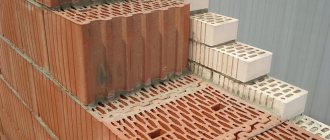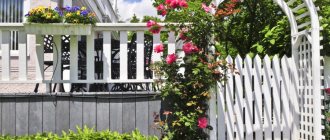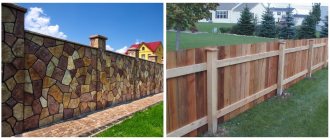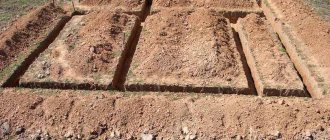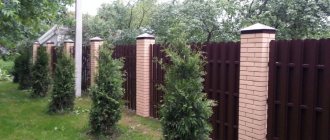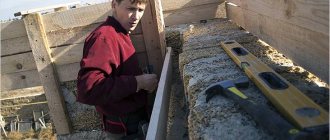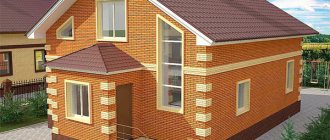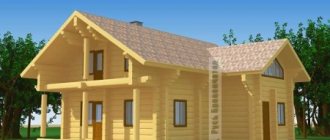What are the benefits of wooden gates?
Despite the emergence of new building materials and technologies, wood still remains relevant. It has undeniable advantages:
- ease of processing - wood is easy to saw, drill, fasten with nails or self-tapping screws;
- natural beauty - it is enough to cover a good tree with transparent protective agents, and it will already be beautiful;
- economical - if you use available and widespread tree species, the gate will be quite cheap;
- light weight, which does not require powerful supports to support.
Wooden gates go well with fences made of corrugated board, forging, brick, and stone. But during operation, you need to take into account that wood is a living material that reacts poorly to high humidity, is susceptible to various types of rot and is not resistant to fire. To preserve the best qualities and neutralize the shortcomings of wood, it is impregnated with antiseptics and fire retardants. Effective protective compounds penetrate deep into the structure of the tree, prevent the development of pathogenic microflora and reduce the fire hazard.
The coating must be updated regularly. It's not too difficult or time consuming. In addition, there are impregnations that protect wood for a long time - up to 5-8 years. The most famous products are from manufacturers from Scandinavian countries, where wood is traditionally widely used in construction. Russian companies today can also offer high-quality paints and impregnations.
Wicket made of corrugated sheets photo
You can make a gate from corrugated sheets with your own hands in several versions. For example, designs are made in the same style as the fence or, conversely, contrast with it. The gate looks great in combination with brickwork or wide pillars made of light stone. You can decorate it using a canopy over the opening, forged edging and other elements, or even hang a mailbox. Using your imagination, it’s easy to create a gate that has a strict, solid or, on the contrary, a bright and fresh look
How to choose lumber
Gates, like street structures, are constantly exposed to harmful factors - precipitation, solar radiation, temperature fluctuations. There are tree species that can withstand unfavorable conditions quite steadfastly:
- Oak is hard, dense, not prone to warping and shrinkage. Its disadvantages are high price and processing complexity. Not every craftsman and not every tool can handle hard, durable wood.
- Larch is extremely resistant to moisture and decay, easy to process, and has a beautiful texture and color. But even such wood requires regular impregnation, which significantly extends the service life of structures.
- Pine is an inexpensive and worthy material that, with proper care, can last quite a long time.
- Spruce is soft; in atmospheric conditions and in contact with the ground, it is prone to rapid rotting. But given the strength of the wood and the economical price, it is quite suitable for the manufacture of fences and gates. It is easy to process, but requires mandatory conservation measures with chemical agents.
To choose a good tree, it is not enough to know only the species. The quality of lumber corresponds to the grade and is determined by the presence of defects, blue stains, cracks, resin pockets and other defects.
Characteristics of suitable wood for making gates
For gates and fencing, it is not necessary to use such expensive varieties as Prima or Extra, but you should still not use grades below 3. When purchasing, pay attention to the correct geometry of the material, the absence of stains, falling knots, and rot.
Example of a damaged board
For the manufacture of gates, lumber that has undergone atmospheric drying is used - timber, timber, edged board, lining, lath. It is not recommended to use raw wood. During the drying process, it will begin to warp, which will irreversibly ruin the appearance of the product.
Forged metal gates
Metal gates can be decorated with forging elements. Such designs in finished form or additional components can be purchased in specialized stores or made to order. Craftsmen can make any decor, even according to your sketch.
The production of a metal gate with forging occurs according to the same principle as from a metal profile. Forged metal decor is attached to the finished gate structure.
Note
When making forged elements, it is important to strictly adhere to the sketch so that no gaps form during fastening.
pros
Forged metal gates have a number of undeniable advantages.
Durability and reliability along with a long service life with proper care.- Environmental friendliness of materials. The metal is completely safe for the human body.
- Attractive appearance and harmonious combination with other types of materials.
Minuses
Disadvantages of forged metal gates:
- Difficulties in manufacturing. It will be very difficult to make such a gate yourself if you do not have experience.
- Expensive.
Caring for metal structures is quite simple. It is enough to first coat the material with anti-corrosion substances and metal paint in 2 layers. Next, you will need to monitor the gate and fence and, if necessary, clean them of dirt and touch up damaged areas.
As you can see, there is nothing complicated in making gates and metal; you can do it yourself. Your main task is to follow the order of actions in the work and draw up a drawing of a metal gate, which will be easier for you to work with.
Types of wooden gates
The most common design is a frame with sheathing attached to it. It is made of wood or metal in the form of a rigid frame of various configurations.
Simple wooden frame
The basis for the gates is a frame made of horizontal bars or boards 40-50 mm thick and jibs, which give the entire structure stability. Sheathing is made of thin slats, boards or other materials.
Here are some simple frame assembly diagrams:
- with two parallel bars and one jib, forming a Z-shaped structure;
- in the shape of a “butterfly” with two intersecting braces;
- with reinforcement with side vertical overlays;
- with two jibs converging at one point.
Z-frame
The wicket frame has intersecting diagonals
Frame for gates with low height
You can make a simple wooden gate with your own hands very quickly:
- The filling is prepared from thin slats of the same width and length in such a way that if they are laid at equal intervals (2-6 cm), the canvas will correspond to the width of the opening.
- The bars are cut according to the size of the canvas. The planks are placed on the bars, screwed with self-tapping screws or nailed with small nails. At each attachment point you need to drive 2 nails or tighten 2 screws.
- The jib is cut so that it fits exactly between the support bars. Fasten to the frame with long screws or nails. The slats are fixed to the jib.
This type of gate is lightweight, but not very strong. It can be used in the country house, in the front garden or in an enclosure for small pets.
https://youtu.be/YxTDZLEET1U
Reinforced wooden frame
Wickets with a frame that includes vertical elements in addition to horizontal and diagonal ones are much more stable. The structure is rigid, deforms less and lasts longer.
Frame elements are cut from timber or boards 40-50 mm thick. They are connected with a tongue-and-groove lock with additional fastening with bolts or self-tapping screws. You can strengthen the corners with metal plates.
Slats, lining, and a thin board are attached to the finished frame-frame. Install the fittings. To hang the gate on the support posts, loops are fixed to the horizontal bars. They can be overhead or mortise. The mating part of the loops is screwed to the posts. The gate is installed in the opening and treated with decorative paints and varnishes.
Metal frame
The combination of a metal frame with various coverings is very common. This is a universal option, suitable also for wooden gates.
To make the frame, use a profile pipe or corner. The frame is assembled with bolts or welded, treated with anti-rust, and primed.
The slats or boards are screwed to the frame with wood-to-metal screws, the end of which is made in the form of a drill with wings. The screw fits easily and securely connects both materials without destroying the wood.
A metal frame is much more durable than a wooden one. If the filling needs to be changed after some time, its dismantling will not be difficult. You will only need to unscrew the screws and remove the worn wooden parts.
Wooden gate for a summer residence step by step instructions with photos
A wooden garden gate looks great - step-by-step instructions with photos will help you make it quickly and easily. The structure will require larch boards. This type of wood is preferable, as it is less susceptible to rotting and has a decorative cut. If desired, you can replace it with pine.
Thus, you need to prepare:
- larch blanks measuring 2000 x 140 x 20 (10 pcs.);
- pine boards 2000 x 150 x 50 (2 pcs.);
- loops (2 pcs.);
- metal toothed plates (6 pcs.);
- brass plates (4 pcs.);
- brass screws (40 pcs.);
- corner;
- latch;
- door handle;
- priming;
- protective agent;
- yacht varnish;
- chisel and hammer;
- hacksaw;
- drill;
- screwdriver;
- jigsaw;
- plane;
- bubble level;
- pencil and brush;
- skin;
- rope.
It is advisable to sketch out a diagram of the gate in advance in order to have an idea of the installation steps.
The gate is made as follows:
Make sidewalls . Loops are attached to them.
Align elements vertically using a level.
Support boards and attach to concrete pillars.
Treat the wood with several layers of antiseptic and protective composition, and cover with yacht varnish.
Install the support bar using self-tapping screws.
Assemble the frame , fastening the corners with brass strips and self-tapping screws.
Strengthen the structure with metal toothed plates , which are pressed into the wood and nailed.
This plate will make the gate reliable and durable.
Adjust the hinges for the gate.
Mount the hinges on the support bar.
Insert the frame into the opening to check the size fits.
Make a strut , which will give rigidity to the structure.
Attach the brace to the frame using plates.
The result is a strong frame for the gate.
Fix the frame to the hinges and cover it with boards. The first workpiece is installed on a support, which is leveled.
There are 2 screws for each sheathing board, 3 for corner boards.
Sew all the boards.
Drill the holes for the self-tapping screws in advance and countersink them so that the caps are slightly buried in the material.
Mount the handle. For ease of work, we advise you not to fasten the second board from the edge yet - through the opening it is easy to reach both sides of the gate.
Using a pencil and string forming a compass, draw circles at the top of the structure.
Using the resulting lines, make cuts with a jigsaw , process the cuts in the same way as the workpieces, only finish with not one, but two layers of varnish.
Install a brass angle that will prevent the hinges from aligning.
Secure the rubber fastener with a self-tapping screw.
These step-by-step instructions with photos will help you make a wooden gate for your dacha without much difficulty.
Sheathing options
It is interesting to decorate the gate using simple but effective techniques. For example, using a combination of planks of different lengths. Short slats are attached alternately with longer ones, having previously cut them in accordance with any ornament. The lower part turns out to be almost dull, and the upper part is light and openwork.
The filling made from a straight or diagonal lattice looks original. It can be on top, bottom or side of the canvas, maintaining the degree of transparency you need.
Exclusive handmade models with a combination of solid filling from boards, openwork grilles, forged elements and carved decorative details look impressive. For such a gate you will need the skill of a carpenter and specialized tools.
A canopy or canopy will complement the look of a wooden gate. They not only add flair, but also protect the entrance area and the structure itself from precipitation.
Accessories for wooden gates
Without accessories - locks, handles, latches, bolts - the gates will not be able to perform their protective functions. Most often, mortise or rim locks are used, although padlocks are also available. Handles - forged, metal or wooden, individual or combined with a lock. A bolt or bolt is placed on the inside to close the gate without a key while at home.
Accessories for street gates and gates are made of galvanized or stainless steel and aluminum. Depending on the design, installation is carried out by inserting into the frame or by overlaying and fixing with mechanical fasteners.
For a simple country gate, the design of the fittings can be without any special frills. For the entrance area to a personal plot, the models should have a more stylish look. Select them in accordance with the gate fittings and fencing finishes.
Installing pillars
Gates can be attached to supports made of various materials - wood, metal, concrete or brick. The depth of the pillar depends on the loads, soil characteristics, and climatic conditions. Usually 0.7-1.2 m is enough, but with weak soils and large freezing depths it can be increased. A layer of crushed stone or sand at least 10 cm thick is poured onto the bottom of the well or pit to drain water and prevent the pillars from being squeezed out in winter.
Fixing metal poles in the ground
Wooden supports are made from debarked logs with a diameter of 10 cm or timber with a cross-section of 150x150 mm. It is recommended to coat the lower part with mastic or waste oil and wrap it with roofing felt. Another option is to burn it with a blowtorch or over a fire. Additionally, you need to dip the bottom of the stand in a clay mash and dry it. This waterproofing lasts for 5-10 years.
For metal racks, use a profile pipe 60x60-80x80 mm or a round one of the same area. The pillars are mounted by driving into the ground, backfilling, and concreting.
Supports made of brick or concrete blocks are laid out with mandatory vertical reinforcement. A pipe, channel or reinforcement cage is installed in the pit, which gives the pillar stability. Then concrete of a grade not lower than M300 is poured. During the masonry process, embedded parts are installed to weld the hinges. Over time, wooden and metal supports may become askew under the weight of a massive gate. To avoid unwanted deformations, the structure is further strengthened by fixing the racks in the lower chord. To do this, dig a shallow trench between them, add crushed stone or sand, lay reinforcement and concrete. Metal poles, if they are of sufficient height, can be connected from above with a piece of pipe or an angle, wooden ones - with a transverse beam.
Manufacturing with installation
Sketch of installation of a metal product on pipe supports
Before making a metal gate, you need to install supporting elements. It is important to secure them well. To do this, it is recommended to concrete them, as well as supports for gates and fences. In the meantime, while the concrete is gaining strength and durability, you can begin manufacturing the product.
If you don’t have the necessary skills to work with metal, then a specialist will help you weld the elements. And if you have the capabilities and skills, it’s time to start manufacturing.
A do-it-yourself metal gate begins to be made from a frame. A square pipe is used for this. All elements must be welded together. Gates and fences are made according to the same principle. Before finally welding all the elements, it is necessary to check each diagonal. This will prevent the need to redo and waste time.
According to the drawing, a place should be provided for the location of the lock and handle. The locking system can be installed on gates and wickets regardless of where they are used - in a country house or in a private house. Garden gates can do without this structural element. The locking system is installed according to the diagram supplied with the kit.
Once the metal frame with all the elements is ready, you can begin attaching the sheathing. To prevent metal elements from corroding, they must be treated with a special metal primer.
Regardless of what material is chosen for the manufacture of a street door, it is important to make drawings and think through all its structural elements. A gate is a mandatory part of the fence for a summer house, private residence or other area.
Compliance with manufacturing technology, all construction rules, and the use of a drawing make it possible to complete all the work with your own hands. Ultimately, the garden or back door of the yard, as well as other gates, will become the decoration of the entire fence and will fully fulfill all their functional loads regarding the protection of private territory.
Assembling the structure
At the first stage, the dimensions of the opening are measured. Most often, the width is 1 m, the height is approximately equal to the height of the fence or lower. If there is a porch in the gate, take into account its width.
Make a drawing of a wooden gate, which will help you correctly cut and assemble the parts. It is necessary to take into account the technological gaps on the sides of the canvas for attaching loops and on the bottom so as not to cling to the track. The gate should move freely.
Elements of a wooden gate
Prepare the frame elements - horizontal and vertical bars, jibs. If the width of the canvas is more than 1 m, it is recommended to strengthen the frame with additional jibs and/or jumpers.
Lumber is trimmed and sanded. To connect with each other, the following methods are used:
- tongue and groove;
- “half a tree”;
- butt with overlay;
- corner.
All connections are reinforced with galvanized fasteners - nails, bolts or wood screws. The frame should be as rigid as possible.
Slatted base
You can buy a picket fence, batten or cladding board already sanded and cut it to size with a small margin for trimming. Install materials according to the chosen pattern, placing them with or without gaps. Fasten to the frame with nails or self-tapping screws, 2 pieces per connection.
After all the slats are nailed, the protruding parts are cut off. You can make a decorative rounding along the top of the gate: tie a thread or thin rope to a nail, attach a pencil to the other end and, holding the nail in the center of the canvas, draw a rounded line. Carefully cutting the slats with a jigsaw along the contour of the arch will now not be difficult.
We fasten the canvas
To hang the gate, use garage or gate hinges with a diameter of 28-34 mm. They are made of high-quality metal and can withstand heavy loads. They are available right or left, some models are equipped with plates for welding to a metal frame. For installation on wooden structures, the planks may have ready-made holes for fasteners.
The loop is disassembled into 2 parts. First, the upper part is attached to the canvas, then a place for the lower part of the loop is marked on the support. The sash is lifted, if necessary, the position of the counterpart is adjusted, and then it is welded or screwed. For a canvas width of up to 0.9 m, 2 hinges are sufficient, above - 3. The hinges on the support must be attached strictly vertically, one below the other. When installing, you need to leave a small gap between the part and the post to prevent rubbing of the supports.
When choosing hinges for a gate, pay attention to whether their design includes a full bearing. It prevents the hinge from skewing and ensures uniform movement without squeaking or rattling.
Wood manufacturing process
Scheme for manufacturing a solid type wooden product
The first thing work begins is the installation of supports. The width between them should correspond to the dimensions of the finished product. All dimensions must be included in the drawings. For comfortable passage, the minimum width of the gate should be 1 meter. Moreover, its height will depend directly on the height of the fence and gate.
If asbestos cement or metal was used as the material for the supports, it is necessary to attach wooden blocks to them at a pre-measured distance. This will allow you to attach the gate to the hinges in the future.
Before making a gate, it is important to treat each wooden element with an antiseptic. This will significantly increase the service life of the product. Treated and dried boards are laid out on a flat surface. They can be packed tightly or spaced at a certain distance. After this, the bars are laid perpendicularly. These elements are located at a distance of 20−30 cm from the top and bottom of the product. In order to give greater strength to the structure, it is worth making a jib. This is a block that is attached diagonally. It must be included in the drawing.
The wooden gate is attached to the fence support using canopies and self-tapping screws. It is important that in the end the wicket, gate and fence look like a single whole. And in order for a wooden product to retain its qualities for a longer period, the surface can be varnished.
Features of the lock mortise
Installing a lock on a wooden gate is easy, much the same as installing a lock on a wooden door. But there are some nuances: when installing the mating part, you need to additionally enlarge the hole in the trim vertically. This is done to compensate for slight vibrations of the pillars as a result of seasonal freezing and thawing of the soil. The lock tongue will fit freely into the locking plate socket. Otherwise, the gate may be difficult to close.
Painting
For exterior work, varnishes, enamels and primers are used to form a protective film on the surface of the wood. They are made on the basis of acrylic, latex, alkyd resins or oils. A distinctive characteristic of materials for wood processing is their high resistance to moisture, frost and UV rays.
In order for the paint to lay evenly and penetrate the wood layer as deeply as possible, the surface must be dried and sanded. For water-based materials, brushes should be medium hard with artificial bristles. Oil-based or alkyd compounds are best applied with a natural bristle brush.
First, the wood is covered with primer, and after it dries - with 2-3 layers of paint. It is applied evenly along the fibers, each layer must be thoroughly dried.
